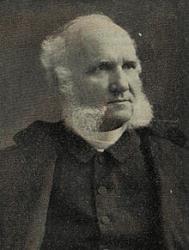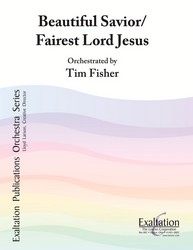- |
User Links
Beautiful Savior

Beautiful Savior, King of Creation
Translator: Joseph Augustus Seiss (1873)Tune: CRUSADERS' HYMN (111271)
Published in 143 hymnals
Printable scores: PDF, MusicXMLPlayable presentation: Lyrics only, lyrics + musicAudio files: MIDI, Recording
Representative Text
1 Beautiful Savior, King of creation,
Son of God and Son of Man!
Truly I'd love Thee, truly I'd serve thee,
Light of my soul, my Joy, my Crown.
2 Fair are the meadows, Fair are the woodlands,
Robed in flow'rs of blooming spring;
Jesus is fairer, Jesus is purer;
He makes our sorr'wing spirit sing.
3 Fair is the sunshine, Fair is the moonlight,
Bright the sparkling stars on high;
Jesus shines brighter, Jesus shines purer
Than all the angels in the sky.
4 Beautiful Savior, Lord of the nations,
Son of God and Son of Man!
Glory and honor, Praise, adoration,
Now and forevermore be Thine!
Translator: Joseph Augustus Seiss
 Joseph A. Seiss was born and raised in a Moravian home with the original family name of Seuss. After studying at Pennsylvania College in Gettysburg and completing his theological education with tutors and through private study, Seiss became a Lutheran pastor in 1842. He served several Lutheran congregations in Virginia and Maryland and then became pastor of St. John's Lutheran Church (1858-1874) and the Church of the Holy Communion (1874-1904), both in Philadelphia. Known as an eloquent and popular preacher, Seiss was also a prolific author and editor of some eighty volumes, which include The Last Times (1856), The Evangelical Psalmist (1859), Ecclesia Lutherana (1868), Lectures on the Gospels (1868-1872), and Lectures on the Epistles (1885… Go to person page >
Joseph A. Seiss was born and raised in a Moravian home with the original family name of Seuss. After studying at Pennsylvania College in Gettysburg and completing his theological education with tutors and through private study, Seiss became a Lutheran pastor in 1842. He served several Lutheran congregations in Virginia and Maryland and then became pastor of St. John's Lutheran Church (1858-1874) and the Church of the Holy Communion (1874-1904), both in Philadelphia. Known as an eloquent and popular preacher, Seiss was also a prolific author and editor of some eighty volumes, which include The Last Times (1856), The Evangelical Psalmist (1859), Ecclesia Lutherana (1868), Lectures on the Gospels (1868-1872), and Lectures on the Epistles (1885… Go to person page >Text Information
Related Texts
| First Line: | Beautiful Savior, King of Creation |
| Title: | Beautiful Savior |
| German Title: | Schönster Herr Jesu |
| Translator: | Joseph Augustus Seiss (1873) |
| Meter: | 5.5.7.5.5.8 |
| Source: | Gesangbuch, Münster, 1677 |
| Language: | English |
| Copyright: | Public Domain |
English
- A Child's Garden of Song #d4
- A Hymnal and Service Book for Sunday Schools, Day Schools, Guilds, Brotherhoods, etc. #391
- A Teaching Hymnal: ecumenical and evangelical #94
- Ambassador Hymnal: for Lutheran worship #177
- American Lutheran Hymnal #623
- Angelic Songs #d17
- Armed Forces Hymnal. Catholic Supplement #d11
- Armed Forces Service Book for Public and Private Use. 2nd rev. ed. #d6
- Army and Navy Service Book for Public and Private Use. Rev. ed. #d7
- Army and Navy Service Book: for Public and Private Use #22 10 shown out of 103
Spanish
Yiddish
Notes
Scripture References:
st. 1 = 1 Tim. 1:17, 1 Tim. 6:16, Dan. 7:9, 13, 22
st. 3 = Isa. 40:28, Isa. 64:6
st. 4 = Isa. 6:2
This hymn expresses love and praise for Christ, the King of creation. The beauty of God's creation is readily affirmed, but the greater praise goes to the King of that creation, the same Christ who is the Lord of the nations! The framing stanzas (1 and 4) constitute a fine doxology.
The original German text ("Schönster Herr Jesu") appeared anonymously in a manuscript dated 1662 in Munster, Germany. It was published in the Roman Catholic Munsterisch Gesangbuch (1677) and, with a number of alterations, in the Schlesische Volkslieder (1842), a hymn book compiled by Hoffman and Richter.
The translation, primarily the work of Joseph A. Seiss (b. Graceham, MD, 1823; d. Philadelphia, PA, 1904), was based on the 1842 edition and first published in the Sunday School Book for the use of Evangelical Lutheran Congregations (1873). Another well known translation based on the 1842 version is the anonymous "Fairest Lord Jesus," published in Richard S. Willis's Church Chorals and Choir Studies (1850).
Seiss was born and raised in a Moravian home with the original family name of Seuss. After studying at Pennsylvania College in Gettysburg and completing his theological education with tutors and through private study, Seiss became a Lutheran pastor in 1842. He served several Lutheran congregations in Virginia and Maryland and then became pastor of St. John's Lutheran Church (1858-1874) and the Church of the Holy Communion (1874-1904), both in Philadelphia. Known as an eloquent and popular preacher, Seiss was also a prolific author and editor of some eighty volumes, which include The Last Times (1856), The Evangelical Psalmist (1859), Ecclesia Lutherana (1868), Lectures on the Gospels (1868-1872), and Lectures on the Epistles (1885). He contributed to and compiled several hymnals.
ST. ELIZABETH appears to be an eighteenth-century tune from the Glaz area of Silesia. It has always been associated with this text. No factual data exists for the legend that this text and tune date back to the twelfth-century crusades, although those apocryphal stories explain one of the names by which this tune is known, namely, CRUSADER'S HYMN. After Franz Liszt used the tune for a crusaders' march in his oratorio The Legend of St. Elizabeth (1862), the tune also became known as ST. ELIZABETH.
Liturgical Use:
The entire text as a hymn of praise at the beginning of worship or as a sermon response; stanzas 1 and 4 (both doxologies) at the end of worship.
--Psalter Hymnal Handbook
Access an additional article on the Canterbury Dictionary of Hymnology:
Tune
CRUSADERS' HYMN (111271)ST. ELIZABETH appears to be an eighteenth-century tune from the Glaz area of Silesia. It has always been associated with this text. No factual data exists for the legend that this text and tune date back to the twelfth-century crusades, although those apocryphal stories explain one of the names by w…
Timeline
Arrangements
Media
Psalter Hymnal (Gray) #461
- Audio recording from Evangelical Lutheran Worship #838
- Audio recording from Lift Up Your Hearts: psalms, hymns, and spiritual songs #17
- Audio recording from Lift Up Your Hearts: psalms, hymns, and spiritual songs #17
- Audio recording from Lift Up Your Hearts: psalms, hymns, and spiritual songs #17
- Audio recording from Lift Up Your Hearts: psalms, hymns, and spiritual songs #17
- MIDI file from Psalter Hymnal (Gray) #461
- MIDI file from Psalter Hymnal (Gray) #461
- MIDI file from With Heart and Voice: songs for all God's children #125
- MIDI file from With Heart and Voice: songs for all God's children #125


 My Starred Hymns
My Starred Hymns






